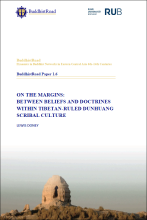BuddhistRoad Paper 1.6 "On the Margins: Between Beliefs and Doctrines within Tibetan-Ruled Dunhuang Scribal Culture"
Synopsis
This article explores the disparity between the Central Tibetan Buddhist doctrines espoused and spread by the Tibetan Empire (Tib. Bod chen po, ca. 7th c. to 842, Bod chen po) and those of the multi-ethnic inhabitants of Dunhuang (敦煌) during the same period. It begins with the multi-ethnic background of the Tibetans themselves and how the Tibetan Empire maintained complex relations with those on its borders, as well as their Buddhism(s). It then unpacks the ‘self-presentation’ of Tri Songdétsen’s (742–ca. 800, Tib. Khri Srong lde brtsan) royal discourse (Tib. bka’ mchid) of doctrine and its spread throughout the Tibetan Empire by means of imperial machinery of state administration. The second half of the paper focuses on Tibetan-ruled Dunhuang (perhaps late 750s/early 760s, or 787, to 848) and evidence of the many different beliefs there not contained in Tri Songdétsen’s royal discourse. It looks at the Aparimitāyurnāmasūtra from the perspective not only of content but also of the evidence of scribal practice spread over its many copies from Mogao Cave 17, also known as the Library Cave (Chin. Cangjing dong 藏經洞). This view from the periphery suggests the variety of Buddhist beliefs not explicitly included in the royal discourse, as well as the varying perspectives on how the Tibetan emperors connect with them and some of the ways in which these influenced the margins of the Tibetan Empire after it fell in the mid-ninth century.
Chinese Translation
本文探讨了西藏帝国 (Bod chen po, 约公元7世纪至842年) 时期, 西藏地区与敦煌多民族杂居区所信仰和传播的藏传佛教教义之间的差异. 文章首先介绍了西藏帝国本身的多民族背景, 以及西藏如何与周边民族和不同地区的佛教保持复杂的关系. 然后解读了赤松德赞 (公元742–约800年, 藏文: Khri Srong lde brtsan) 所诰谕 (藏文: bka’ mchid) 的教义的“自我呈现”以及这些教义通过帝国行政机构在整个西藏的传播. 本文的后半部分着重于西藏治下的敦煌 (可能是公元750年代末/760年代初, 或787年至848年), 以及赤松德赞的诰谕中没有涉及的其他众多不同信仰的证据. 本文对《无量寿经》的研究, 不仅包含其内容, 还涉及莫高窟第17窟(又称藏经洞)中所藏的其众多副本所展现的抄经文化. 这种外部视角指出了诰谕中没有明确包括的各种佛教信仰, 以及西藏皇帝如何与之联系的不同观点, 还有这些信仰在九世纪中期西藏帝国灭亡后影响其边隅地区的一些方式.

Downloads
Published
Categories
License

This work is licensed under a Creative Commons Attribution-NonCommercial-NoDerivatives 4.0 International License.

